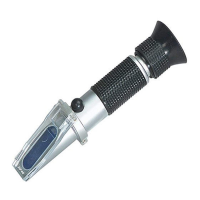RF40 V1.2 4/04
3
Operation
The instrument measures the refractive index of the sample.
1. Zero Adjustment
Place one or two drops of distilled water on the prism. Close the cover plate and
rotate the adjusting screw so that the light/dark boundary lines up with the
“waterline”. Once the zero adjustment has been completed, clean the prism with soft
cloth
2. Sample Preparation and Reading
To take a sample reading, simply place a few drops of a sample liquid on the
measurement prism at the end of the instrument. Lower the cover plate onto the
sample and prism.
While holding the instrument under a light source, look through the eyepiece. The
freezing point of the liquid or the state of the battery liquid is determined by the
intersection of the boundary of the light and dark fields (known as the shadowline)
on the printed scale. If the scale appears out of focus, the eyepiece may be adjusted
by rotating the knurled portion. The instrument also features an eye guard to prevent
stray light from entering the eyepiece and causing reflections.
It may be necessary to adjust the position of the light source to maximize the
contrast of the shadowline. Under normal conditions, optimal contrast is obtained by
holding the instrument underneath and perpendicular to a light source.
Once a reading has been taken, wipe dry with a clean cloth (do not wash or rinse)
and place the instrument in the supplied plastic case. Store the instrument in a safe,
dry environment.
Temperature is one of the single most important factors influencing accurate
refractometer readings and is one of the largest sources of error in measurement.
Temperature compensation relieves the user of the responsibility to measure
temperature and apply a correction factor when taking readings. This refractometer
makes this correction automatically. When ambient temperature varies from 68°F
(20°C), readings are automatically adjusted to compensate for temperature variance
between 50°F to 86°F (10°C to 30°C).
Open the prism cover and
place 2 or 3 drops on the
prism. Close the cover so the
liquid spreads across the entire
surface of the prism without air
bubbles or dry spots. Allow the
sample to remain on the prism
for approximately 30 seconds.
Bad Bad
Good

